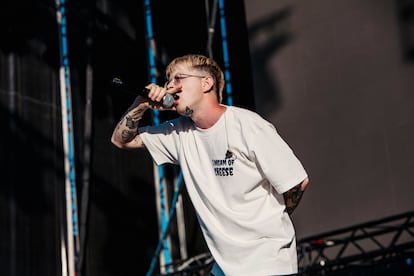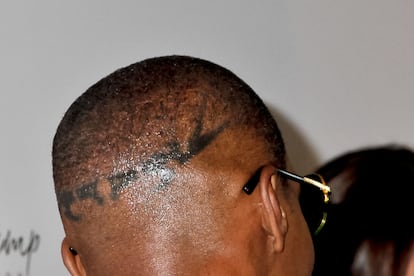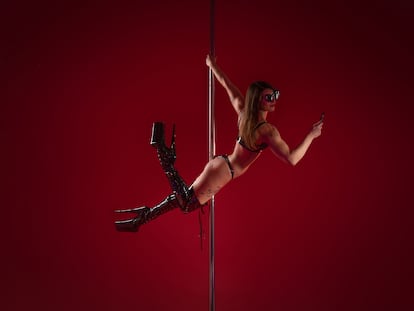‘The last frontier’: What it’s like to live with a tattoo on your face
Inking your face was once a daring practice among eccentric stars, such as Mike Tyson. But, for some time now, it’s made the jump into everyday life… although a tattooed face is still viewed with a fair bit of fear

“Face tattoos aren’t what they used to be,” said trap singer Pimp Flaco during a recent interview in Spain. “It’s not like five years ago. Now, it’s almost normal. Before — when only four or five of us in Spain had our faces tattooed — it was something crazy. It was like saying, ‘I hate everything.’ But now, even I’m too lazy to do more, because [face tattoos] just make it seem like you want to look cool.”
For years, the Barcelona-based artist had a rose tattooed on his right temple: “Yes, yes, it was super normal, my grandmother has a couple of friends with their faces tattooed.” It’s still weird to have a tattoo on your face… but it’s also undeniable that, in recent years, this practice has ceased to be the exclusive property of the world of trap and urban music.
To begin with, before the rappers started doing it, Mike Tyson was a pioneer in face tattoos. Back in 2003, he planted a tribal tattoo in the middle of his face. He said that it highlighted his “warrior spirit.”
After Tyson came the generation that invented trap, which elevated facial tattoos to the category of an esthetic movement. Kinder Malo, the singer and brother of Pimp Flaco, became a living manifesto by tattooing the phrase “animals aren’t food” on his forehead. Cecilio G, another Barcelona trap artist known both for his music and his controversies, sports an unfinished Gyarados (a type of Pokémon) on his abdomen, as well as the hammer-and-sickle on one of his biceps. However, his most distinctive feature is the cross that adorns his forehead, for which he has never provided an explanation.
Fellow Spanish trap singer Yung Beef has his children’s names written on his face, while his bandmate Kaydy Cain sports a kiss on one side of his face and an ice cream cone on the other. During his appearance on a Spanish television program, Yung Beef explained that, when he got his designs done, he made an irrevocable commitment to music. He was aware that, with face tattoos, the doors to conventional jobs would be closed.

In the post-trap era, different pop culture icons have immersed themselves in the world of face tattoos, with varying degrees of daring. Justin Bieber inscribed the word “grace” above his eyebrow, as a subtle declaration of faith. British actress Cara Delevingne got a tattoo of a diamond inside her right ear and, on the outside of the same ear, she engraved four stars in the shape of the Southern Cross constellation, a symbol of Brazil that was inked during a trip to Rio de Janeiro. Actor Jamie Foxx has a large tribal tattoo on the back of his head that, according to what he said in an interview, he got for his 40th birthday.
The next, somewhat inevitable step is that the face tattoo has finally hit the streets. “Unquestionably, these types of tattoos have become a trend in recent years,” explains literary critic and literature professor Nadal Suau, in a conversation with EL PAÍS. He classifies facial tattoos under the category of “unruly tattoos.” This group also includes ironic tattoos. He also adds what he calls “ugly, dirty or violent” tattoos — such as painting the anus of a cow on your skin — are part of “a bad taste that disobeys the imperative of homogeneous beauty.”
“I will probably never get a tattoo on my face… although, obviously, you never know,” the critic admits. “It can be considered the last frontier — [it’s] the type of tattoo that hasn’t yet been normalized, it still maintains the ability to cause concern, to provoke questions, to capture the gaze of the passerby. Even though fashion has attempted to capitalize on this trend, a strong element of taboo persists.” He claims that a face tattoo can radically change the perception that others have of the person who bears it. “And beyond the gaze of others, a change as extreme and beastly as a tattoo on the face can profoundly influence how a person sees themselves,” he reflects.

Nadal Suau directly links the trend of face tattoos with the emergence of the trap movement a few years ago. “In fact, in the recent history of tattooing, it has often been music stars — especially rock figures, much more than athletes — who have driven the development of this art form. It’s the [trap stars] who’ve placed the facial tattoo in the spotlight, making it into an esthetic trend,” he affirms. The critic underlines the influence of youth countercultural movements on the decisions of those who decide to get tattoos. “The most recent change — the one that leads someone like me to get tattoos — is rooted in these countercultures. Among them, music has always played a prominent role, due to its character as the most universally accessible art and its ability to unite groups, from the times of Janis Joplin to the present-day.”
This past February, Julia Bermejo, who has worked as a bookseller for 15 years, decided to get a sun with boots tattooed on one of her cheeks. This was designed by JLR, a Sevillian tattoo artist who reinterprets Andalusian imagery with a personal touch. At the time, she already had several tattoos on her body. “My mother would say many, I would say a few,” she jokes. She got her first one when she was 17 or 18. “It was a time when there weren’t so many tattooed people, but I had [an obsession].” She didn’t mark her body again until she was 30. “I had a shitty breakup and I thought the best thing was to leave a record. Sometimes, we give tattoos the same meaning as the entry in our diary… but [we write it] on our own skin.”
After that tattoo, others followed, forming a collection mostly adhering to the style called “blackwork,” accompanied by certain elements of traditional tattooing. The decision to get a face tattoo arose more from a spontaneous impulse than from detailed planning. “I saw designs and people with tattoos on their faces, until, suddenly, I decided to do it. It’s similar to having a book on your bedside table for seven weeks and, one day, just like that, you read it in one sitting.”
Regarding working in front of the public in a bookshop, she points out that, as a woman, there will always be criticism and prejudices to face, regardless of how she acts or presents herself. “What do you want me to say? You’re always going to be too childish or too banal for some people. And it doesn’t matter: even if I was dressed perfectly, someone would always come in who wasn’t going to take me seriously.”

Bermejo tattoos herself while respecting sensitivity and visibility. “It’s advised that beginners initially avoid highly sensitive areas such as the stomach to be able to get used to the process first. [It’s best to start] in less painful and more discreet areas,” she explains. This makes it easier for the person to discover their pain tolerance and reaction to the tattoo. Bermejo has come to the conclusion that, even if one wants to, “there are social codes that are difficult to transcend.” That’s why she’s chosen to respect the unofficial rules. “For me, doing it this way is the healthiest thing. Although, of course, if someone wants to violate these codes, that’s fine too.”
Álvaro Costa — better known as Cos.915 in the tattoo scene — identifies with a new trend of artists who don’t follow certain traditional rules or the established ethics that dictate a specific order for tattooing. “No offense, I think that perspective is a bit old-fashioned,” he shrugs. He started off in this world at the age of 16 as a hobby. But after three or four years, he decided to become a professional in this artistic discipline.
Like other members of the new generation of tattoo artists, he makes it a rule to exclusively engrave his own designs. “For me, there are two big worlds within tattooing. One [is made up by] the traditional studios… there, the client can get the design they want, while the tattoo artist is limited to doing it for them. Let’s say that it’s an entirely artisanal method. On the other hand, I only tattoo my own designs. Sometimes, I can adjust it to an idea that the client has… but I only work from my own ideas.”
He’s done several face tattoos — a practice that he considers to be increasingly common. “I’ve tattooed very cute designs, like butterflies and above all flowers, generally in the area of the sideburns, next to the ear. At the moment, only for guys,” he says. From his perspective, any stigma attached to facial tattoos is an outdated concept. The real commitment lies in what the tattoo itself symbolizes. “A swastika tattoo would undoubtedly have consequences no matter where you get it. But a flower, for example, denotes sensitivity. It also depends on how you approach your life, or in what circles you move. I’ve seen people in Europe working with tattoos on their faces in all kinds of jobs.”

After Argentina’s victory during the 2022 World Cup in Qatar, a soccer fan went viral after tattooing “Messi D10S” on his forehead. At first, he was probably absorbed by the atmosphere of collective euphoria. But, just a couple of weeks later, he posted a video on social media, in which he regretted the decision. “I felt very proud for the first few days, but I must confess that I regret having gotten the tattoo,” he lamented. “Instead of bringing me positive things, I’m experiencing thousands of negative things personally, [as is my] family.”
He added that his closest relatives criticized him for “not being a positive example for society.” Luckily for this young man, just as the trend of face tattoos is becoming more common, treatments to erase them are also improving.
Sign up for our weekly newsletter to get more English-language news coverage from EL PAÍS USA Edition
Tu suscripción se está usando en otro dispositivo
¿Quieres añadir otro usuario a tu suscripción?
Si continúas leyendo en este dispositivo, no se podrá leer en el otro.
FlechaTu suscripción se está usando en otro dispositivo y solo puedes acceder a EL PAÍS desde un dispositivo a la vez.
Si quieres compartir tu cuenta, cambia tu suscripción a la modalidad Premium, así podrás añadir otro usuario. Cada uno accederá con su propia cuenta de email, lo que os permitirá personalizar vuestra experiencia en EL PAÍS.
¿Tienes una suscripción de empresa? Accede aquí para contratar más cuentas.
En el caso de no saber quién está usando tu cuenta, te recomendamos cambiar tu contraseña aquí.
Si decides continuar compartiendo tu cuenta, este mensaje se mostrará en tu dispositivo y en el de la otra persona que está usando tu cuenta de forma indefinida, afectando a tu experiencia de lectura. Puedes consultar aquí los términos y condiciones de la suscripción digital.
More information
Archived In
Últimas noticias
Most viewed
- Reinhard Genzel, Nobel laureate in physics: ‘One-minute videos will never give you the truth’
- Oona Chaplin: ‘I told James Cameron that I was living in a treehouse and starting a permaculture project with a friend’
- Pablo Escobar’s hippos: A serious environmental problem, 40 years on
- Why we lost the habit of sleeping in two segments and how that changed our sense of time
- Charles Dubouloz, mountaineering star, retires at 36 with a farewell tour inspired by Walter Bonatti











































